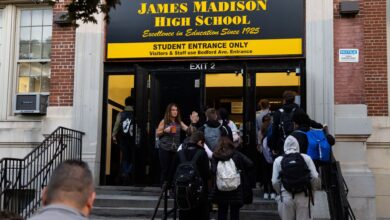These are the weapons Ukraine needs to win

If you think the war in Ukraine has turned a corner thanks to the $60-million supplemental passed last month, think again.
True, some US-provided weapons have started arriving on the frontlines, but Russians continue to enjoy an “absolute advantage” in their firepower, as President Zelensky’s advisor Mikhaylo Podolyak said this week.
Even under the most optimistic of scenarios, the current levels of international assistance are not enough to allow Ukraine to launch major offensive operations.
At best, the hope is that Ukraine manages to stabilize the existing lines and that it continues to degrade Russian logistics and supply lines with high-precision, long-range strikes — including against targets inside of Russia.
To achieve the former goal, Ukrainians will need to match or exceed Russian firepower on the frontlines and secure their skies.
For the latter, they need far more high-precision, long-range capabilities — and Biden’s permission to use them.
On both of those fronts, the United States and our allies are doing a miserable job.
Ukraine currently operates three Patriot systems — one of them protecting Kyiv, while large cities such as Odesa and Kharkiv continue to be pummeled.
According to Zelensky, the country would need 25 of them (each with 8 batteries) to bring Russian strikes to a halt.
Ukrainians also continue to be plagued by a shortage of 155-milimeter shells, which neither the United States nor Europe produce at a sufficient scale.
That has prompted the Czech leadership to build a coalition of countries that are sourcing such shells for Ukraine from the stockpiles of countries across Asia, Latin America, and the Middle East.
Alas, the Russians are doing the same — and they are sometimes able to pony up the cash faster than European governments whose agility is constrained by the need for democratic accountability and transparency.
Even if we assume that both challenges are quickly addressed, Ukraine cannot win the war without inflicting decisive blows to Russia’s war machine.
Ukrainians have already had great successes with their use of HIMARS and the UK- and French-provided Storm Shadow/SCALP missiles.
Russia’s Black Sea fleet is in hiding, the use of Crimea as a launchpad for new attacks has become problematic, and Ukraine has already targeted Russia’s oil refining capacity.
The Biden administration has long sought to dissuade Ukraine from striking inside Russia, reflecting both its fears over escalation and a quintessentially election-year concern over high oil and gas prices.
The partial permission it gave this week to strike targets in Russia in the defense of Kharkiv goes in the right direction but is inadequate.
Not only should Ukraine be allowed to strike against relevant targets in Russia, it should be given the best tools to do so.
Reportedly, Ukraine is already using a small number of ATACMS — an army ballistic system with a range of 186 miles.
There is no reason why they should not be getting more.
More importantly, the US Air Force has a stock of several thousand Joint Air-to-Surface Standoff Munitions, or JASSMs.
Those are subsonic, virtually undetectable cruise missiles with a range of 230 miles.
In 2018, United States used them, successfully, to destroy Syria’s chemical weapons laboratory at the Barzah Research Center.
The centrality of JASSMs is bound to increase as Ukraine finally receives its deliveries of F-16 fighters, which too are coming late and in cripplingly small numbers.
Arguably, Ukraine will not be using those jets for dogfights; rather their primary value would be in launching JASSM strikes against Russian targets far behind the frontlines.
As President Biden prepares to host the 75th-anniversary NATO summit in Washington, he has an opportunity to demonstrate that the United States can lead and not just equivocate.
Providing Ukraine with a sizeable shipment of JASSMs, alongside fighter jets and effective air defenses, would have the added benefit of incentivizing the more fearful Europeans — German Chancellor Olaf Scholz in particular — to do more.
While the international pressure on Germany to supply Ukraine with its highly capable Taurus systems has already been strong, seeing Ukraine use ATACMs and JASSMs at scale would make Berlin’s position untenable.
Ukraine can win — but it cannot do so unless the Biden administration commits to its victory.
On top of the obvious items such as Patriots and munitions, dispatching high-precision long-range systems to Kyiv and giving Ukraine the blessing to use them should be a no-brainer.
Dalibor Rohac is a senior fellow at the American Enterprise Institute in Washington DC. Twitter: @DaliborRohac.




